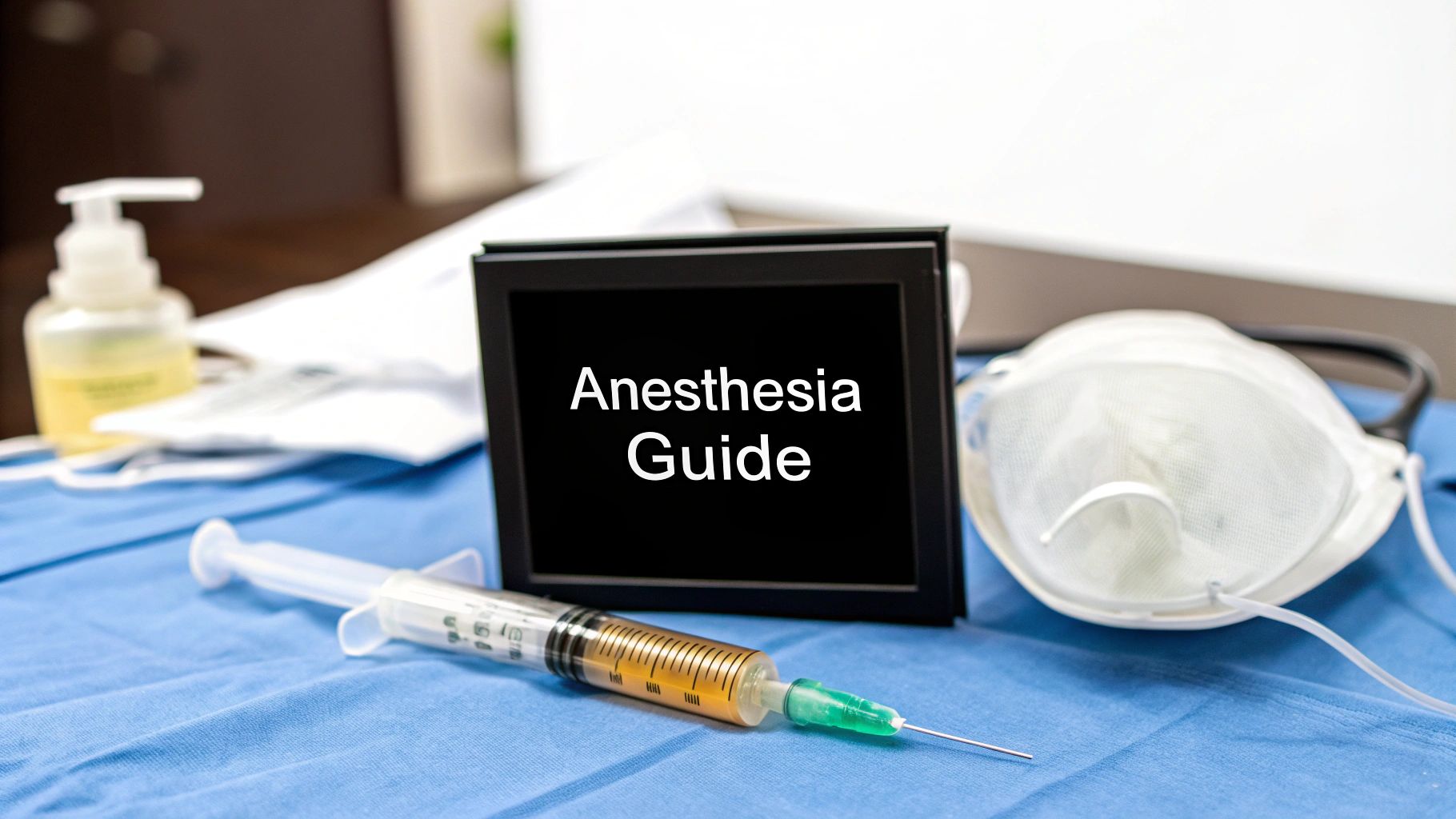
October 12, 2025
Anesthesia Types for Surgery A Patient's Guide
Discover the main anesthesia types for surgery. This guide explains general, regional, local, and sedation to help you prepare for your procedure.
Oct 11, 2025
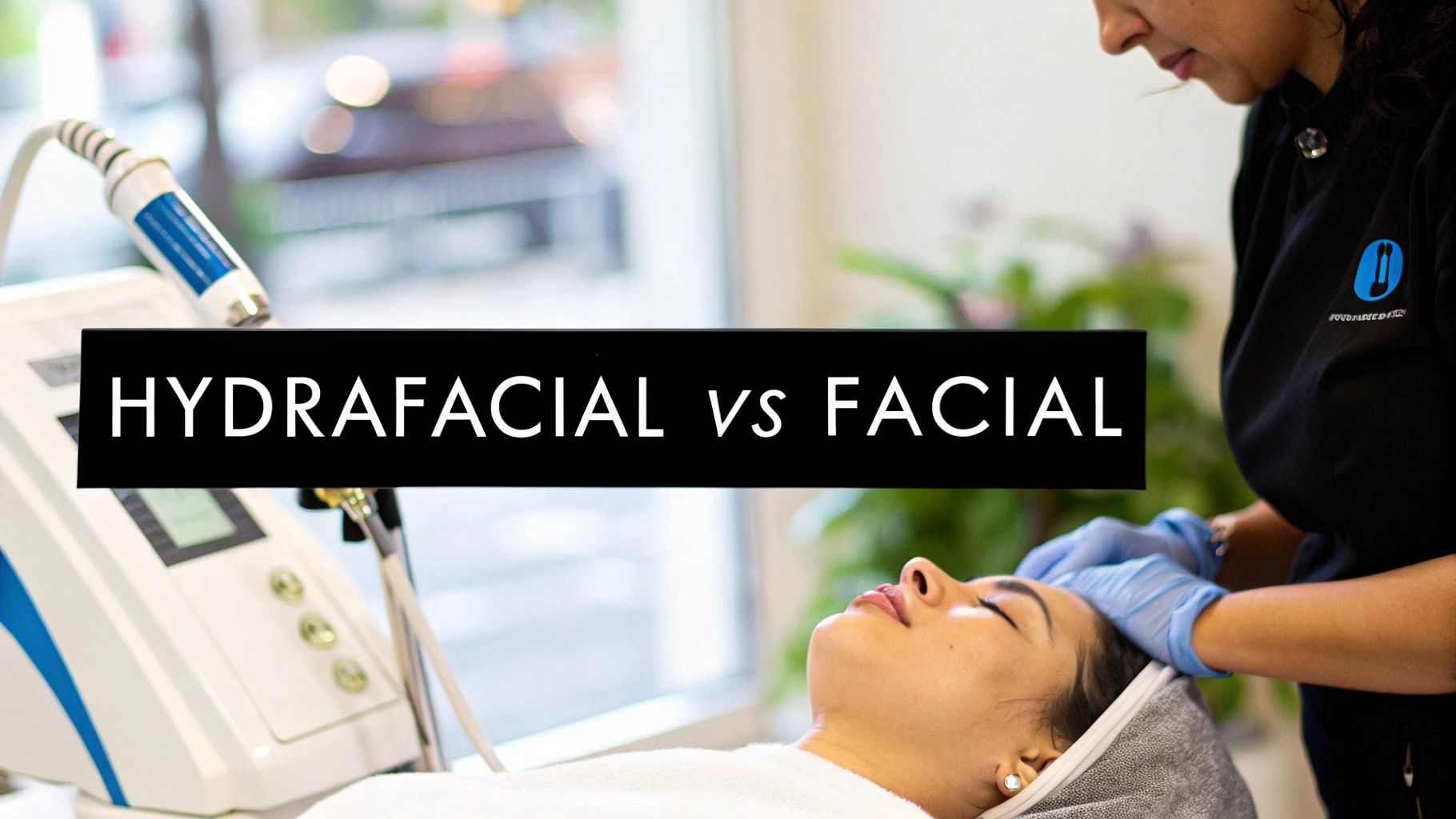
The fundamental difference between a Hydrafacial and a regular facial really comes down to one thing: technology versus touch.
A Hydrafacial uses a special vortex-fusion device to deliver a very consistent, machine-driven treatment every single time. On the other hand, a traditional facial is all about the esthetician's hands-on skill—think manual extractions, facial massage, and customized mask applications.
Your choice really hinges on what you're looking for. Are you after immediate, noticeable results and a serious glow, or are you craving a relaxing, personalized skincare ritual?
When you’re weighing these two popular treatments, it helps to get into the nitty-gritty of how they work. While both are designed to boost your skin's health, they get there in completely different ways, and each has its own set of advantages.
The Hydrafacial is a standardized, multi-step process that delivers reliable, predictable outcomes. This consistency has made it a favorite among the many non-invasive and laser treatment options available today. A regular facial, however, is more of an art form, uniquely shaped by the expertise and intuition of a skilled esthetician.
This visual gives a quick rundown of the main distinctions in how they're performed, what to expect afterward, and how they stack up in cost.
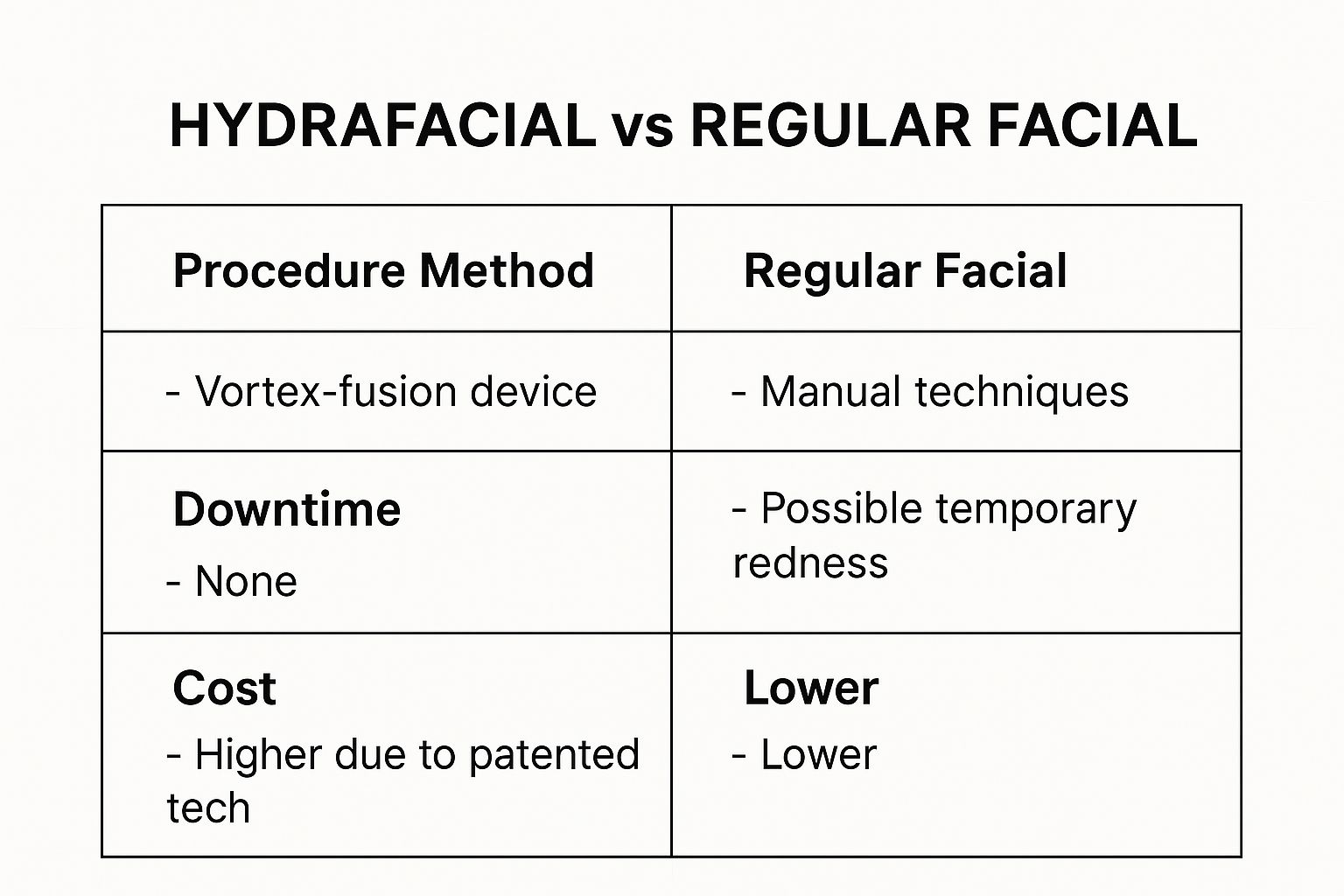
As you can see, the Hydrafacial's higher price point is directly tied to its advanced technology and the promise of zero downtime. This is a stark contrast to the more traditional—and often more affordable—hands-on approach of a regular facial.
To make the choice even clearer, it's useful to see the core features of each treatment side-by-side. This table breaks down exactly what you can expect from both.
Seeing them laid out like this makes the decision-making process much simpler. You can quickly see which treatment aligns better with your budget, schedule, and ultimate skin goals.
If there’s one thing to take away, it's this: A Hydrafacial is about predictable, technology-driven efficiency. A regular facial offers a classic, therapeutic experience that’s completely tailored by human touch.

Unlike a regular facial that relies on manual techniques, a Hydrafacial is all about its patented vortex-fusion technology. This isn't just a fancy name; it's a system that uses a special spiral-tipped wand to perform a consistent, three-step process every single time.
If you've never had one, the sensation is often described as a cool paintbrush moving gently across your face. It's a prime example of how technology is redefining personal care for smooth skin. The device methodically cleanses, extracts, and hydrates without the pinching or pressing you might be used to.
The treatment kicks off with resurfacing. The spiral tip glides over the skin, delivering a gentle mix of glycolic and salicylic acids. This creates a very mild chemical peel effect to slough off dead cells and reveal a fresher layer of skin underneath.
Think of this as prepping the canvas. It clears the way for the next steps by getting rid of surface-level gunk and starting to loosen up the debris in your pores.
Here's the part everyone loves. Instead of an esthetician manually squeezing out blackheads, the Hydrafacial wand uses a gentle but powerful vacuum suction. It literally pulls the oil, blackheads, and other impurities right out of your pores.
But here's the clever bit: as it's suctioning everything out, it's also drenching your skin with intense moisturizers. This two-in-one action is a game-changer in the hydrafacial vs regular facial comparison, as it cleans pores deeply without the usual redness or irritation. The painless suction is a world away from traditional extractions.
The real magic of the Hydrafacial lies in its ability to extract impurities and infuse beneficial serums at the same time. This multi-tasking approach minimizes stress on the skin while maximizing the delivery of active ingredients.
The final step is all about locking in the results. Your skin's surface is saturated with a cocktail of powerful antioxidants and peptides to nourish, protect, and give you that signature Hydrafacial glow.
This is also where the treatment gets personal. The serums can be customized with special "boosters" to zero in on your specific concerns.
This ability to customize takes the treatment far beyond a standard facial, offering targeted solutions delivered with incredible precision. You walk out with skin that feels profoundly clean, hydrated, and ready to face the world.
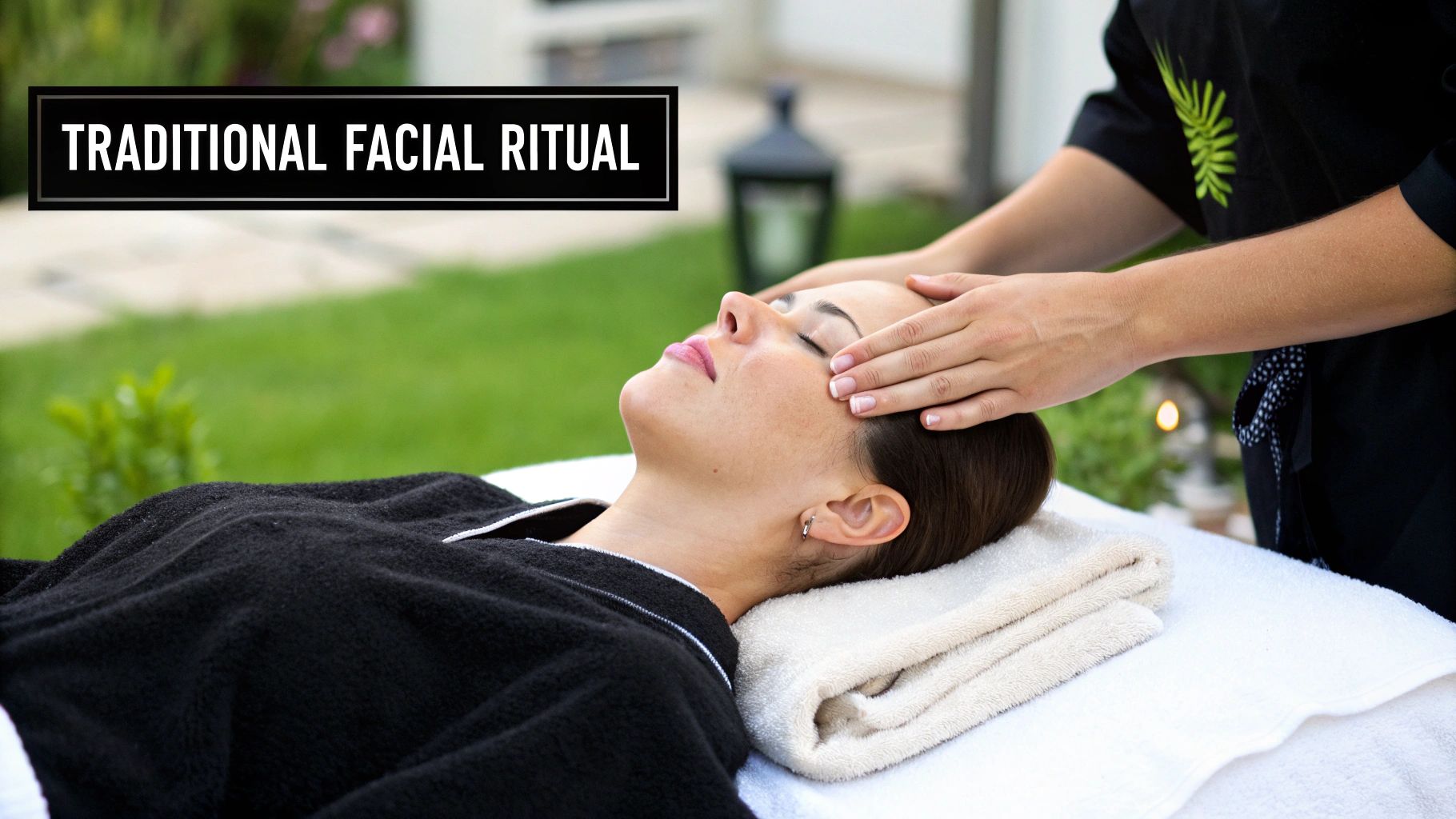
While a Hydrafacial brings technology to the forefront, a traditional facial is all about the art of human touch and proven skincare techniques. It's a classic for good reason, delivering a deeply personalized and therapeutic experience that a machine just can't duplicate.
The whole treatment is guided by the skilled hands and trained eye of a professional esthetician. They adjust every single step—from the specific products they choose to the massage pressure they apply—based on what your skin needs at that very moment. It's a truly custom ritual.
A regular facial follows a more flexible, multi-stage process that starts with a close-up skin analysis. This initial consultation is crucial, as it allows the esthetician to map out a treatment plan just for you.
This hands-on method means every detail gets careful attention. A typical session involves several core stages designed to cleanse, treat, and relax your skin.
The real magic of a traditional facial is its adaptability. An esthetician can decide to spend more time on stubborn extractions or extend the massage if you need to de-stress, offering a level of personalization that is entirely human-driven.
A traditional facial does more than just make your skin look good; it’s an experience designed to calm your mind, too. The quiet room, the soothing aromas, and the therapeutic touch all work together to create a true escape.
This is where it really stands out for anyone looking for stress relief along with their skincare. The hands-on massage boosts circulation, helping deliver more oxygen and nutrients to your skin cells, which is the secret to that healthy, natural glow. It’s a time-tested approach that has been trusted for generations, focusing on both immediate results and long-term skin health.
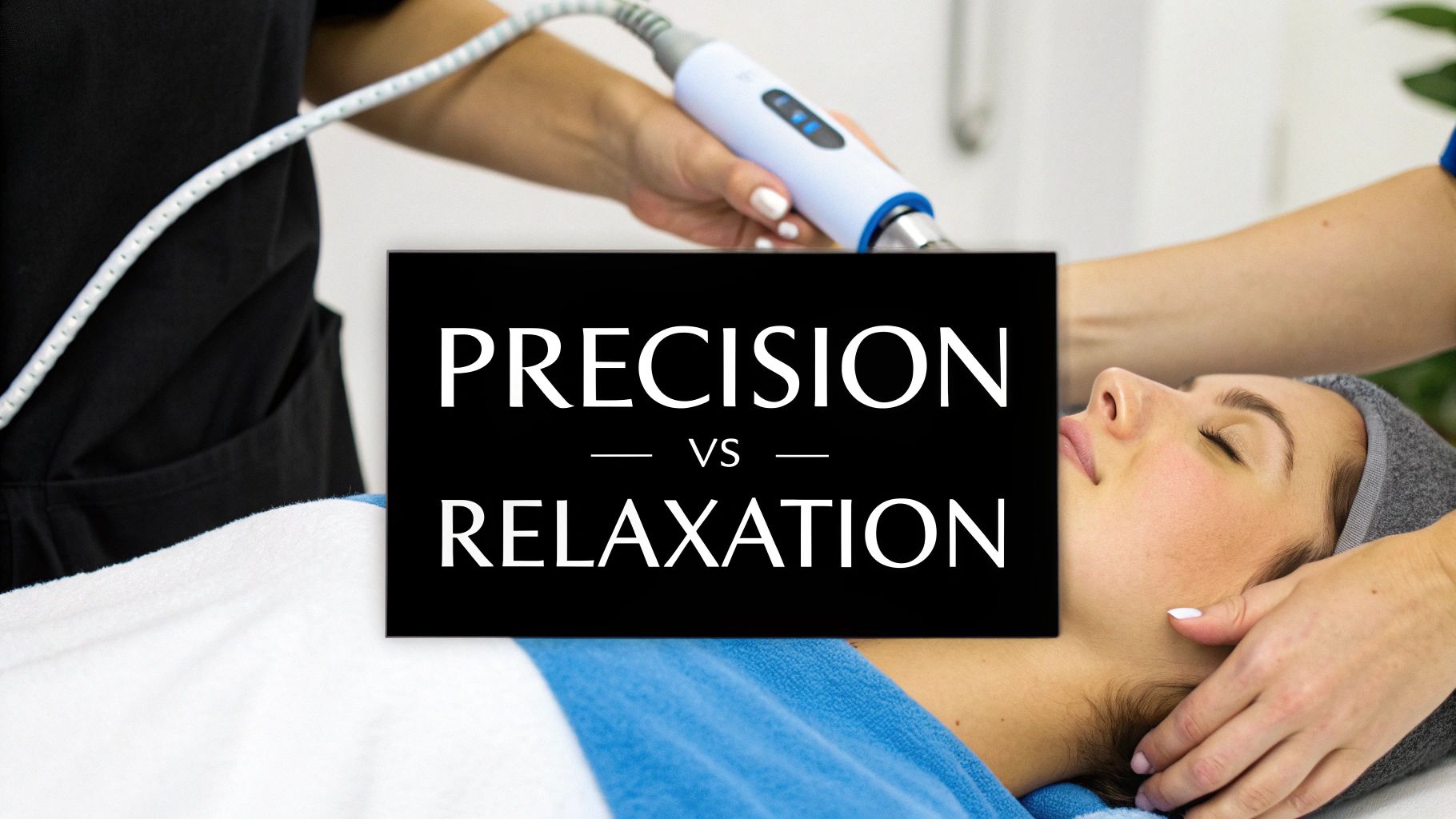
When you're trying to choose between a Hydrafacial and a regular facial, what it really boils down to is the experience itself and the results you see in the mirror afterward. Both treatments want to give you better skin, but the path they take to get there—and what you walk away with—are worlds apart.
A classic, traditional facial is all about the human touch. The process usually involves manual extractions, which, let's be honest, can be a bit uncomfortable as the esthetician clears out clogged pores. But that momentary discomfort is often balanced by a deeply relaxing facial massage, a cornerstone of the experience that's meant to soothe your muscles and boost circulation.
The Hydrafacial, on the other hand, is a technology-driven experience. People often describe the sensation as a cool, gentle vacuum gliding across the skin. There's no pinching, pressing, or prodding involved, which makes it a much more pleasant process, especially if you have sensitive skin or just don't love the feeling of extractions.
One of the biggest selling points of a Hydrafacial is how fast you see the results. You literally walk out of the clinic with skin that is visibly brighter, smoother, and incredibly hydrated. This makes it the go-to treatment before a big event—you get that reliable, camera-ready glow with absolutely zero downtime.
A regular facial, while still great for your skin, doesn't always provide that same instant "wow" factor. The results can be more subtle at first, with the focus being more on deep cleaning and pure relaxation. In fact, because of the manual extractions, it's pretty common to have some redness for a day or two. That means you’ll want to book it a few days before any major plans. These treatments, much like some chemical peels, are really part of a long-game strategy for skin maintenance.
The core difference lies in their primary function. A Hydrafacial is engineered for predictable, technology-driven results you can see right away. A traditional facial offers a customized, therapeutic experience focused on skin health and relaxation.
The hydrafacial vs regular facial debate also touches on consistency. A Hydrafacial follows a standardized, three-step process that ensures you get the same quality outcome every single time, no matter who performs it. You can add personalized boosters, but the fundamental treatment doesn't change.
A traditional facial is, by its nature, much more variable. The outcome really hinges on the skill and intuition of your esthetician. This allows for an incredibly personalized session where the professional can adapt their techniques in real-time to what your skin needs that day, creating a truly one-of-a-kind treatment.
When it comes to longevity, Hydrafacials often have an edge. The deep hydration and exfoliation can keep skin looking smooth and clear for several weeks, making a real dent in concerns like fine lines and acne. While a traditional facial leaves you feeling refreshed and relaxed, you'll likely need more frequent appointments to maintain similar, long-lasting skin improvements.
Let's talk money, because that’s a huge part of the hydrafacial vs regular facial decision. It's easy to look at the price tags and see a clear winner, but the real story is in the value you get for your investment. A traditional facial is almost always the more budget-friendly option, making it a fantastic entry point into professional skincare.
A Hydrafacial, on the other hand, comes with a higher upfront cost. This isn't just a random price hike; you're paying for the sophisticated tech behind the treatment. The cost covers the patented vortex-fusion device, the single-use tips that guarantee a sterile and effective session every time, and the high-quality, targeted serums that get pushed deep into your skin.
When you’re weighing the cost, think beyond a single session. Consider the return on your investment over time. While you’ll spend more on one Hydrafacial, its powerful and consistent results can deliver better long-term value, especially if you’re trying to tackle specific issues like fine lines, rough texture, or stubborn dark spots.
Because the effects of a Hydrafacial are often more dramatic and last longer, you might actually need fewer appointments throughout the year to keep your skin looking its best. A regular facial is cheaper per visit, but you may need to go more often to achieve and maintain similar results, which could even out the cost over the long haul.
For targeted, corrective goals, a Hydrafacial can be a more efficient investment. For general maintenance and relaxation, a regular facial offers excellent value.
The prices for these treatments also tell a story about what’s happening in the skincare world. Traditional facials have long been a spa staple, with prices generally falling between $50 and $150. But lately, there’s been a huge surge in demand for treatments that give you quick, noticeable results without any downtime.
This shift has made advanced procedures like the Hydrafacial incredibly popular. A single session usually runs between $150 and $300, and its popularity is still climbing, especially with younger people who have busy schedules and want to see immediate results. You can read more about these evolving skincare trends and their market impact on drswethacosmodermcentre.com.
Ultimately, it all boils down to what you want to achieve. If your main goal is a relaxing, pampering experience that supports overall skin health, a traditional facial is a wonderful and affordable choice. But if you’re looking for a serious, corrective treatment that delivers a reliable, instant glow, the investment in a Hydrafacial often pays for itself with results you can see and feel.
So, when it comes to the hydrafacial vs regular facial debate, how do you make the final call? It really boils down to what you need right now—your immediate skin goals, your current skin condition, and even your lifestyle. There's no single right answer; it's about matching the treatment to your specific situation.
Think about what's on your calendar. If you have a big event coming up—a wedding, a reunion, a major presentation—the Hydrafacial is almost always the better choice. It’s incredibly reliable for that instant, camera-ready glow, and with zero downtime, you can have the treatment in the morning and be out that same evening.
A Hydrafacial is your go-to if you’re looking for immediate, noticeable results and want to tackle specific issues like texture or uneven tone.
And if you’re looking to take things a step further for deeper textural issues or stubborn fine lines, you might even consider treatments like Genius RF Microneedling as part of a more comprehensive skin plan.
A traditional facial is the perfect fit when your goals are more about relaxation, deep manual cleansing, or if you're keeping an eye on your budget.
Your decision should be guided by your primary objective. Choose a Hydrafacial for technological precision and a guaranteed glow. Opt for a traditional facial for customized, hands-on care and deep relaxation.
Ultimately, knowing how to choose the right facial for your skin type is the most important part of the process. Take a good look at your skin. Is it looking dull and just needs a quick reset? Or is it congested and in need of some careful, detailed work? Answering that question will point you straight to the right treatment.
Choosing between a HydraFacial and a traditional facial can bring up a few last-minute questions. Let's clear those up so you can feel completely confident about your next skincare appointment.
Absolutely. In fact, a HydraFacial is often a fantastic option for people with sensitive skin. Instead of the squeezing and pressure of manual extractions, it uses a gentle vacuum-based technology that's much less likely to cause irritation.
The treatment is also highly customizable. The serums can be adjusted to specifically soothe and hydrate your skin, but it's always smart to have a quick chat with your esthetician first to make sure it's the perfect match for you.
To keep your skin looking its best, most experts recommend getting a HydraFacial every 4 to 6 weeks. This timing is ideal for tackling ongoing concerns like fine lines, clogged pores, and uneven texture.
A classic facial, on the other hand, is a wonderful monthly treat for general maintenance. It provides a consistent deep cleanse and a bit of relaxation, fitting well into most routines and budgets.
One of the biggest draws of the HydraFacial is its zero downtime. You can literally walk out of the appointment and go about your day with an immediate, visible glow. A regular facial, especially one with manual extractions, might leave you with some temporary redness for a day or so.
At Cape Cod Plastic Surgery, our experienced team is here to guide you toward the treatment that will deliver the results you're looking for. Ready to find your path to healthy, glowing skin? Schedule your consultation today.

October 12, 2025
Discover the main anesthesia types for surgery. This guide explains general, regional, local, and sedation to help you prepare for your procedure.
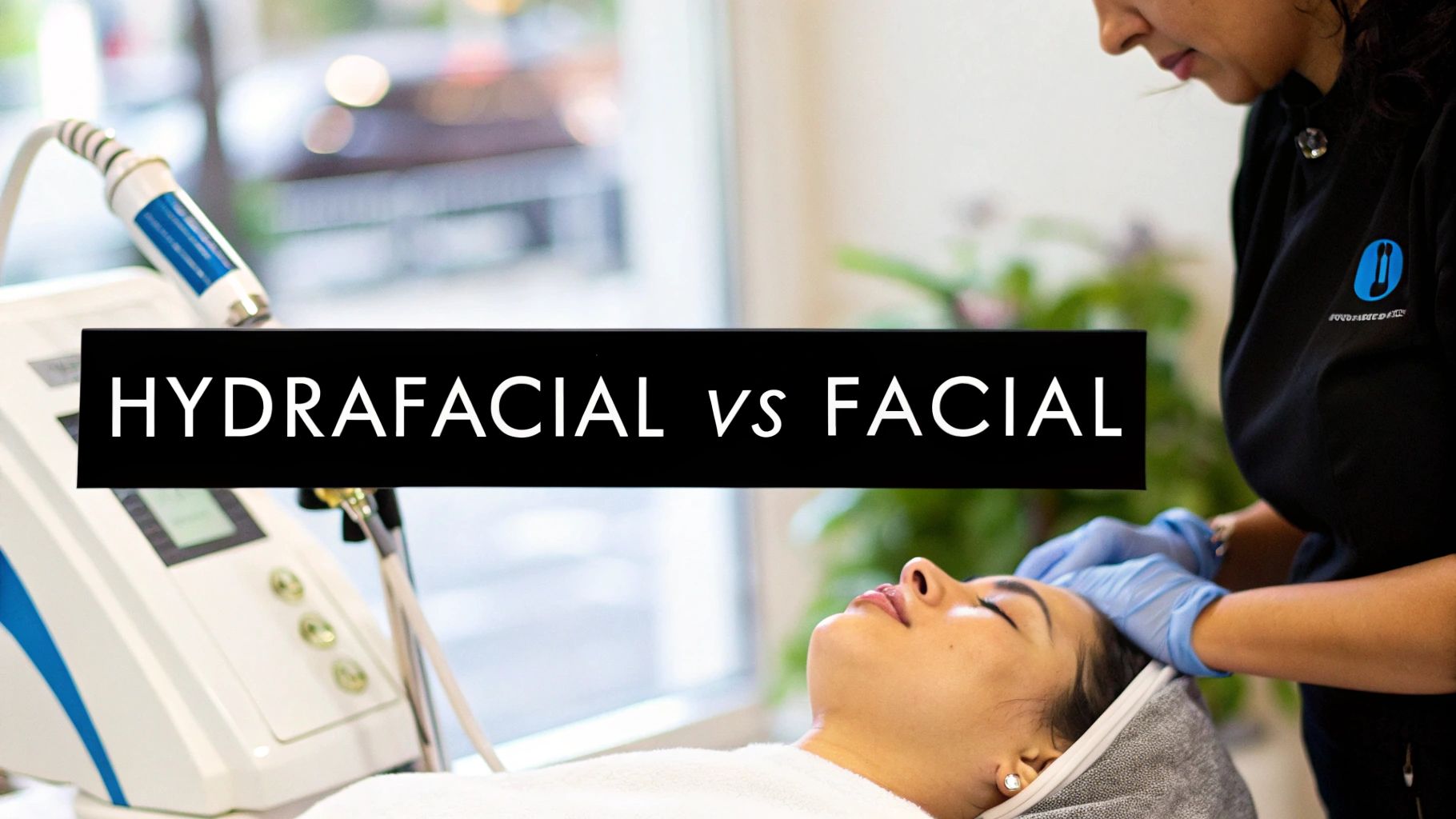
October 11, 2025
Learn the key differences between hydrafacial vs regular facial to choose the right treatment for glowing, healthy skin. Read our expert guide now!

October 10, 2025
Explore the best treatments for sagging skin, from non-invasive to surgical options. Find the perfect solution to restore your youthful appearance.